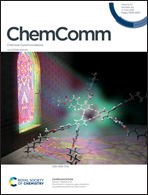Selenium-atom-modified thymidine enhances the specificity and sensitivity of DNA polymerization and detection†
Abstract
Nucleobase mismatches can jeopardize DNA polymerization specificity, causing mutations and errors in DNA replication and detection. Herein we report the first synthesis of novel 2-Se-thymidine triphosphate (SeTTP), describe the single-selenium atom-specific modification strategy (SAM) against T/G mismatches, and demonstrate SAM-assisted polymerization and detection with much higher specificity and sensitivity. SAM can effectively suppress the formation of non-specific products in DNA polymerization and detection. Thus, SAM enhances the specificity of DNA synthesis by approximately 10 000 fold, and in turn, it allows the detection of clinical COVID-19 viral RNA in low copy numbers (single-digit copies), while the conventional RT-qPCR does not.



 Please wait while we load your content...
Please wait while we load your content...